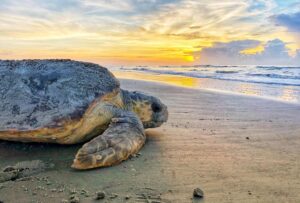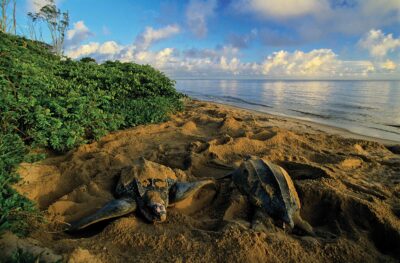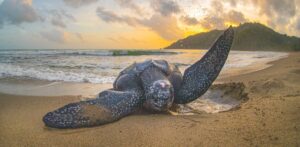Ever wondered what’s on the plate for leatherback sea turtles? These ocean giants are like the rockstars of the sea, cruising through waves with their cool leathery shells. But let’s get down to the important stuff – their foodie preferences! So, what do leatherback sea turtles eat?
It turns out, their menu is more than just a random assortment of ocean snacks. On this page, we will dive into the intriguing world of these flippered foodies and discover the tasty treats that keep them swimming strong in our vast oceans. Get ready for a delicious journey into the dining habits of leatherback sea turtles.
What do leatherback sea turtles eat? 30 Varieties you should know

Leatherback sea turtles (Dermochelys coriacea) have a diverse diet that primarily consists of jellyfish, but they are known to consume a variety of other organisms as well. Here are 30 things that leatherback sea turtles may eat:
- Jellyfish: The primary component of their diet.
- Sea Jellies: Various species of jellyfish.
- Comb Jellies: Another type of gelatinous marine organism.
- Salps: Gelatinous, barrel-shaped planktonic tunicates.
- Pyrosomes: Colonial organisms made up of small zooids.
- Ctenophores: Comb jellies, which are translucent, gelatinous marine animals.
- Squid: Particularly small squid species.
- Cuttlefish: Cephalopods related to squids and octopuses.
- Octopus: Another cephalopod that leatherbacks may consume.
- Shrimp: Various species of small crustaceans.
- Crabs: Small crabs may be part of their diet.
- Sea Urchins: Echinoderms with spines.
- Sea Cucumbers: Echinoderms with elongated bodies.
- Small Fish: Leatherbacks may consume small fish species.
- Anemones: Cnidarians with stinging tentacles.
- Corals: Some leatherbacks may feed on coral polyps.
- Sea Pens: Soft coral colonies resembling old-fashioned quill pens.
- Hydroids: Small, predatory marine animals related to jellyfish.
- Sargassum Seaweed: Floating brown algae that provides habitat and potential food.
- Seagrasses: In some cases, leatherbacks may graze on seagrass.
- Macroalgae: Large seaweeds that may be part of their diet.
- Sea Stars: Echinoderms that may be prey for leatherbacks.
- Sea Snails: Some leatherbacks may consume small snails.
- Sea Slugs: Nudibranchs and other marine gastropods.
- Sponges: Simple aquatic animals with porous bodies.
- Plankton: Small organisms that float in the water.
- Fish Eggs: Leatherbacks may consume the eggs of various fish species.
- Algae: Microscopic and macroscopic forms of algae.
- Tunicates: Marine filter-feeders, also known as sea squirts.
- Bryozoans: Aquatic invertebrates that form colonies.
Please know that the availability of these food sources can vary depending on the leatherback sea turtle’s location and the specific environmental conditions. Additionally, their preference for jellyfish makes up a significant portion of their diet.
Primary food sources
The primary food source for leatherback sea turtles is jellyfish. These turtles are highly specialized predators adapted to feed on gelatinous organisms. They have distinctive adaptations in their mouth and throat, including backward-pointing spines called papillae, which help them capture and consume jellyfish efficiently.
While jellyfish make up the majority of their diet, leatherback sea turtles can also consume a variety of other gelatinous organisms. This includes different species of sea jellies, comb jellies (ctenophores), and other soft-bodied invertebrates. Their feeding habits are opportunistic, and they may consume other types of prey if available in their habitat.
Leatherback sea turtles are considered keystone species in marine ecosystems due to their role in controlling jellyfish populations. They help maintain a balance in the ocean food web by preventing jellyfish from overpopulating and negatively impacting other marine organisms.
Also, the availability of food sources can vary depending on the turtle’s location and the specific environmental conditions of its habitat. Conservation efforts are crucial to protect leatherback sea turtles and ensure the preservation of their essential role in marine ecosystems.
Importance of Jellyfish in Leatherback Diet



